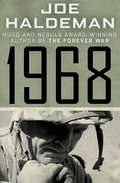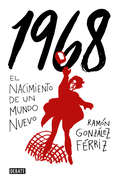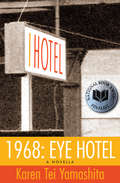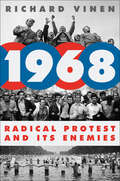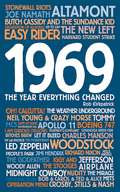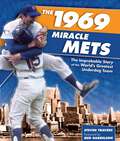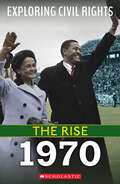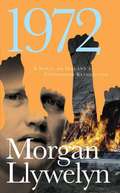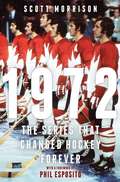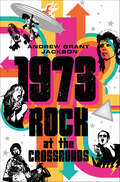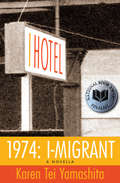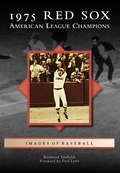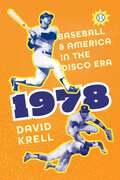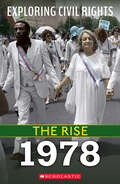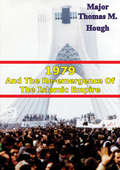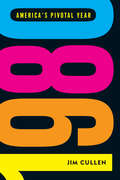- Table View
- List View
1968: A Novel
by Joe Haldeman&“So many tensions and so much emotion . . . A powerful novel&” of the Vietnam era by the award-winning author of The Forever War (Booklist). John &“Spider&” Spiedel is a college dropout who is drafted into the war as a combat engineer. Scared, he tries to keep his head down and stay safe, a plan that works until the Tet Offensive, when he is wounded and sent stateside—and receives a devastating diagnosis. And while he&’s been away fighting, his girlfriend, Beverly, has fallen in with the hippie movement in an attempt to rebel against the repressive values of American society and the injustice of the war that took her boyfriend overseas. Vietnam was the conflict that changed America&’s relationship with war forever, and this novel by Nebula and Hugo Award–winning author Joe Haldeman, inspired by his own experience in the military, is a look at this turbulent time in US history as seen through the eyes of the people most affected: the soldiers and their loved ones. 1968 is not just a story of two young people attempting to find themselves in a tumultuous world—it&’s the account of a country trying to find itself as well.This ebook features an illustrated biography of Joe Haldeman including rare images from the author&’s personal collection.
1968: El nacimiento de un mundo nuevo
by Ramón González FérrizUn recorrido por el revolucionario 1968, el año en que se rebelaron los jóvenes de todo el mundo. 1968 se ha convertido en una especie de mito. Pero más allá de esa imagen idílica o confusa, fue un año lleno de acontecimientos políticos que provocaron la extendida sensación de que el mundo estaba al borde del colapso. En Francia y en Estados Unidos, en Checoslovaquia, México, Japón, Italia, Alemania y España, 1968 fue el año en que los sistemas políticos fueron cuestionados, sobre todo, por unos jóvenes estudiantes convencidos de que el mundo que les legaban sus padres era aburrido, injusto y criminal. Sin un plan concreto, pero armados con nuevas ideologías de izquierdas, una retórica audaz y unas tácticas de protesta que imitaban a las de las guerrillas, rompieron los grandes consensos políticos y culturales que habían estado en pie desde el final de la Segunda Guerra Mundial. 1968. El nacimiento de un mundo nuevo es una crónica de ese convulso año de grandes esperanzas y de sueños de un mundo mejor, pero también lleno de muertes violentas como las de Martin Luther King y Bobby Kennedy y disturbios como los de París, Tokio, Roma, Berlín y Madrid. Fue el año en que gobiernos como el de México se volvieron contra sus ciudadanos, las fuerzas del Pacto de Varsovia invadieron Checoslovaquia, se estableció el embrión de varios grupos terroristas como la Fracción del Ejército Rojo y las Brigadas Rojas, y ETA cometió su primer asesinato. Todo ello con el trasfondo ineludible de la guerra de Vietnam.
1968: El nacimiento de un mundo nuevo
by Ramón González FérrizUn recorrido por el revolucionario 1968, el año en que se rebelaron los jóvenes de todo el mundo. 1968 se ha convertido en una especie de mito. Pero más allá de esa imagen idílica o confusa, fue un año lleno de acontecimientos políticos que provocaron la extendida sensación de que el mundo estaba al borde del colapso. En Francia y en Estados Unidos, en Checoslovaquia, México, Japón, Italia, Alemania y España, 1968 fue el año en que los sistemas políticos fueron cuestionados, sobre todo, por unos jóvenes estudiantes convencidos de que el mundo que les legaban sus padres era aburrido, injusto y criminal. Sin un plan concreto, pero armados con nuevas ideologías de izquierdas, una retórica audaz y unas tácticas de protesta que imitaban a las de las guerrillas, rompieron los grandes consensos políticos y culturales que habían estado en pie desde el final de la Segunda Guerra Mundial. 1968. El nacimiento de un mundo nuevo es una crónica de ese convulso año de grandes esperanzas y de sueños de un mundo mejor, pero también lleno de muertes violentas como las de Martin Luther King y Bobby Kennedy y disturbios como los de París, Tokio, Roma, Berlín y Madrid. Fue el año en que gobiernos como el de México se volvieron contra sus ciudadanos, las fuerzas del Pacto de Varsovia invadieron Checoslovaquia, se estableció el embrión de varios grupos terroristas como la Fracción del Ejército Rojo y las Brigadas Rojas, y ETA cometió su primer asesinato. Todo ello con el trasfondo ineludible de la guerra de Vietnam.
1968: Eye Hotel (I Hotel #1)
by Karen Tei Yamashita"Eye Hotel" is the first novella of I Hotel, a National Book Award finalist and epic of America's struggle for civil rights as it played out in San Francisco's Chinatown. Yamashita's cast of students, laborers, artists, revolutionaries, and provocateurs make their way through the history of the day, caught in riptides of politics and passion, clashing ideologies and personal turmoil.
1968: Radical Protest and Its Enemies
by Richard VinenA major new history of one of the seminal years in the postwar world, when rebellion and disaffection broke out on an extraordinary scale.The year 1968 saw an extraordinary range of protests across much of the western world. Some of these were genuinely revolutionary—around ten million French workers went on strike and the whole state teetered on the brink of collapse. Others were more easily contained, but had profound longer-term implications—terrorist groups, feminist collectives, gay rights activists could all trace important roots to 1968.1968 is a striking and original attempt half a century later to show how these events, which in some ways still seem so current, stemmed from histories and societies which are in practice now extraordinarily remote from our own time. 1968 pursues the story into the 1970s to show both the ever more violent forms of radicalization that stemmed from 1968 and the brutal reaction that brought the era to an end.
1968: The Year That Rocked the World
by Mark KurlanskyIn this monumental new book, award-winning author Mark Kurlansky has written his most ambitious work to date: a singular and ultimately definitive look at a pivotal moment in history. With1968, Mark Kurlansky brings to teeming life the cultural and political history of that world-changing year of social upheaval. People think of it as the year of sex, drugs, and rock and roll. Yet it was also the year of the Martin Luther King Jr. and Bobby Kennedy assassinations; the riots at the Democratic National Convention in Chicago; Prague Spring; the antiwar movement and the Tet Offensive; Black Power; the generation gap, avant-garde theater, the birth of the women's movement, and the beginning of the end for the Soviet Union. From New York, Miami, Berkeley, and Chicago to Paris, Prague, Rome, Berlin, Warsaw, Tokyo, and Mexico City, spontaneous uprisings occurred simultaneously around the globe. Everything was disrupted. In the Middle East, Yasir Arafat's guerrilla organization rose to prominence . . . both the Cannes Film Festival and the Venice Biennale were forced to shut down by protesters . . . the Kentucky Derby winner was stripped of the crown for drug use . . . the Olympics were a disaster, with the Mexican government having massacred hundreds of students protesting police brutality there . . . and the Miss America pageant was stormed by feminists carrying banners that introduced to the television-watching public the phrase "women's liberation. " Kurlansky shows how the coming of live television made 1968 the first global year. It was the year that an amazed world watched the first live telecast from outer space, and that TV news expanded to half an hour. For the first time, Americans watched that day's battle-the Vietnam War's Tet Offensive-on the evening news. Television also shocked the world with seventeen minutes of police clubbing demonstrators at the Chicago convention, live film of unarmed students facing Soviet tanks in Czechoslovakia, and a war of starvation in Biafra. The impact was huge, not only on the antiwar movement, but also on the medium itself. The fact that one now needed television to make things happen was a cultural revelation with enormous consequences. In many ways, this momentous year led us to where we are today. Whether through youth and music, politics and war, economics and the media, Mark Kurlansky shows how, in1968,twelve volatile months transformed who we are as a people. But above all, he gives a new understanding to the underlying causes of the unique historical phenomenon that was the year 1968. Thoroughly researched and engagingly written-full of telling anecdotes, penetrating analysis, and the author's trademark incisive wit--1968 is the most important book yet of Kurlansky's noteworthy career.
1968: Those Were the Days
by Brian Williams1968 was the year when humans first glimpsed the far side of the Moon, but also the year the world was shocked by assassination, by the crushing of hope for reform and by wars that showed no sign of ever ending. To the old there seemed too much change, too quickly, with youth in revolt, though against what no one was entirely sure … ‘Hey Jude’, sang the Beatles, with a refrain that lingered long into the summer night, ‘Don’t make it bad, take a sad song and make it better’...
1969
by Rob KirkpatrickFor the fortieth anniversary of 1969, Rob Kirkpatrick takes a look back at a year when America witnessed many of the biggest landmark achievements, cataclysmic episodes, and generation-defining events in recent history. 1969 was the year that saw Apollo 11 land on the moon, the Cinderella stories of Joe Namath's Jets and the "Miracle Mets," the Harvard student strike and armed standoff at Cornell, the People's Park riots, the first artificial heart transplant and first computer network connection, the Manson family murders and cryptic Zodiac Killer letters, the Woodstock music festival, Easy Rider, Kurt Vonnegut's Slaughterhouse-Five, the Battle of Hamburger Hill, the birth of punk music, the invasion of Led Zeppelin, the occupation of Alcatraz, death at Altamont Speedway, and much more. It was a year that pushed boundaries on stage (Oh! Calcutta!), screen (Midnight Cowboy), and the printed page (Everything You Always Wanted to Know about Sex), witnessed the genesis of the gay rights movement at Stonewall, and started the era of the "no fault" divorce. Richard Nixon became president, the New Left squared off against the Silent Majority, William Ayers co-founded the Weatherman Organization, and the nationwide Moratorium provided a unifying force in the peace movement. Compelling, timely, and quite simply a blast to read, 1969 chronicles the year through all its ups and downs, in culture and society, sports, music, film, politics, and technology. This is a book for those who survived 1969, or for those who simply want to feel as alive as those who lived through this time of amazing upheaval.
1969 Miracle Mets: The Improbable Story of the World's Greatest Underdog Team
by Steven TraversIn the 1977 movie Oh, God!, George Burns, playing the deity, is asked to prove his divinity by performing a miracle. Burns replies, &“The last miracle I did was the 1969 Mets. Before that, I think you have to go back to the Red Sea.&” This book tells the tale of the single most impossible, unbelievable, and wonderful sports story of all time—of the 1969 &“Amazin&’ Mets&” and their incredible spring, summer, and fall. But it does much more than simply recount how the worst sports franchise ever ascended to greatness in a few short months. The 1969 Miracle Mets is the story of tumultuous times: the 1960s. Against the backdrop of the Vietnam War, the New York Mets proved to be a metaphor for a changing America and, in retrospect, the catapult for the eventual comeback of a battered-yet-unbowed Metropolis. Tom Seaver and his teammates come alive in these pages as the final symbols of an innocent age, an age when the greatest icons in American culture—New York sports heroes—mounted the stage in awesome splendor, before Watergate, before free agency, before the mercenaries took over.
1969: The Year Everything Changed
by Rob KirkpatrickIn 1969, man landed on the moon; the "Miracle Mets" captivated sports fans; students took over college campuses and demonstrators battled police; America witnessed the Woodstock music festival; Hollywood produced Easy Rider; Kurt Vonnegut published Slaughterhouse-Five; punk music was born; and there was murder at Altamont Speedway. Compelling, timely, and a blast to read, 1969 chronicles the year in culture and society, sports, music, film, politics, and technology. This rich, comprehensive history is perfect for those who survived 1969 or for those who simply want to feel as though they did.
1969: The Year Everything Changed
by Rob KirkpatrickFEATURING A NEW INTRODUCTION, THIS IS THE SEMINAL AND CLASSIC BOOK ON THE YEAR THAT DEFINED A GENERATION! 1969. The very mention of this year summons indelible memories. Woodstock and Altamont. Charles Manson and the Zodiac Killer. The televised events of the moon landing and Ted Kennedy’s address after Chappaquiddick. The Amazin’ Mets and Broadway Joe’s Jets. The Stonewall Riots and the Days of Rage. Americans pushed new boundaries on stage, screen, and the printed page. The first punk and metal albums hit the airwaves. Swinger culture became chic. The Santa Barbara oil slick and Cuyahoga River fire highlighted growing ecological devastation. The nationwide Moratorium and the breaking story of the My Lai massacre inspired impassioned debate on the Vietnam War. Richard Nixon spoke of “The Silent Majority” while John and Yoko urged us to “Give Peace a Chance.” In this rich and comprehensive narrative, Rob Kirkpatrick chronicles an unparalleled year in American society in all its explosive ups and downs.
1970 (Exploring Civil Rights)
by Selene CastrovillaLearn about the key events of the civil rights movement in the latest installment of this exciting and informative series.The year 1970 was one of hope in the civil rights movement in education, politics, and the arts. In January, Dr. Clifton Wharton, Jr., became the first African American president of Michigan State University. The first publication of Essence magazine launched in May, focusing on culture, beauty, fashion, and entertainment for Black women in America. In June, Kenneth Allen Gibson was elected as the first African American mayor of a major Northeast city — Newark, New Jersey. And in August, Charles Edward Gordone became the first African American playwright to win the Pulitzer Prize for Drama for his play, No Place to Be Somebody, about a Black bartender trying to survive in New York City.This detailed account explains why 1970 was such a critical year in the civil rights movement.ABOUT THE SERIES:The years from 1967 to 1978 were critical to the civil rights movement. Resistance was often met with violence against Black Americans struggling to end discrimination and segregation. Yet the courage of those yearning for equal opportunities under the law continued to persevere and set the stage for even more progress in the coming decades. Discover how this specific time period brought about change and how it still affects us as a society today.With stunning photographs throughout and rich back matter, each book focuses on a specific year and chronologically follows the detailed events that occurred and the changes that took place.
1970: "I" Hotel
by Karen Tei Yamashita"I Hotel" is the third novella of I Hotel, a National Book Award finalist and epic of America's struggle for civil rights as it played out in San Francisco's Chinatown. Yamashita's cast of students, laborers, artists, revolutionaries, and provocateurs make their way through the history of the day, caught in riptides of politics and passion, clashing ideologies and personal turmoil.
1971
by Srinath RaghavanThe war of 1971 was the most significant geopolitical event in the Indian subcontinent since its partition in 1947. At one swoop, it led to the creation of Bangladesh, and it tilted the balance of power between India and Pakistan steeply in favor of India. The Line of Control in Kashmir, the nuclearization of India and Pakistan, the conflicts in Siachen Glacier and Kargil, the insurgency in Kashmir, the political travails of Bangladesh--all can be traced back to the intense nine months in 1971. Against the grain of received wisdom, Srinath Raghavan contends that far from being a predestined event, the creation of Bangladesh was the product of conjuncture and contingency, choice and chance. The breakup of Pakistan and the emergence of Bangladesh can be understood only in a wider international context of the period: decolonization, the Cold War, and incipient globalization. In a narrative populated by the likes of Nixon, Kissinger, Zhou Enlai, Indira Gandhi, Zulfikar Ali Bhutto, Sheikh Mujibur Rahman, Tariq Ali, George Harrison, Ravi Shankar, and Bob Dylan, Raghavan vividly portrays the stellar international cast that shaped the origins and outcome of the Bangladesh crisis. This strikingly original history uses the example of 1971 to open a window to the nature of international humanitarian crises, their management, and their unintended outcomes.
1972 (Exploring Civil Rights)
by Selene CastrovillaLearn about the key events of the civil rights movement in the latest installment of this exciting and informative series.The year 1972 was one of major accomplishments in the civil rights movement. In January, Shirley Chisolm became an inspiration as the first African American to seek the presidential nomination of a major political party. In February, Wilt Chamberlain won the NBA title for the Los Angeles Lakers and was named the Most Valuable Player, securing his place as one of the most talented athletes in the history of sports. The National Black Political Convention was held in March with a crowd of ten thousand African Americans to discuss and advocate for Black communities that were in economic and social crisis across the country. And in November, Andrew Jackson Young Jr., of Georgia, and Barbara Jordan from Texas became the first African Americans in the twentieth century elected to Congress from the Deep South.This detailed account explains why 1972 was such a critical year in the civil rights movement.ABOUT THE SERIES:The years from 1967 to 1978 were critical to the civil rights movement. Resistance was often met with violence against Black Americans struggling to end discrimination and segregation. Yet the courage of those yearning for equal opportunities under the law continued to persevere and set the stage for even more progress in the coming decades. Discover how this specific time period brought about change and how it still affects us as a society today.With stunning photographs throughout and rich back matter, each book focuses on a specific year and chronologically follows the detailed events that occurred and the changes that took place.
1972 Black Hills Flood, The (Images of America)
by Corey ChristiansonOver 50 years have passed since the Black Hills flood swept through western South Dakota in 1972, leaving tragedy in its wake. This book explores the extent of the damage through images that highlight Rapid City, Keystone, and the surrounding Black Hills. Dignitaries, including Sen. George McGovern, visited the Black Hills in the aftermath; these visitors, along with the actions taken for recovery, make an appearance in the story. Today, the Black Hills are a tourist destination, with Mount Rushmore National Memorial, Crazy Horse Memorial, and Custer State Park being the most well-known attractions. /Corey Christianson has spent years researching the 1972 Black Hills flood. She was a part of the 50th commemoration of the flood, for which she, along with a team of talented individuals, created an award-winning exhibit about the flood and the recovery of the Black Hills. The images in this book are from the Rapid City Public Library, US Air Force, Keystone Area Historical Society, and other organizations that strive to remember, honor, and commemorate the flood. /
1972: A Novel of Ireland's Unfinished Revolution
by Morgan LlywelynThe story of Ireland from 1950-1972 through the eyes of a young newspaper photographer, son and grandson of Irish revolutionaries.
1972: The Series That Changed Hockey Forever
by Scott MorrisonThe legacy of the greatest hockey series ever played, fifty years later, with stories from the players that shed new light on those incredible games and times.&“Cournoyer has it on that wing. Here&’s a shot. Henderson made a wild stab for it and fell. Here&’s another shot. Right in front...they score! Henderson has scored for Canada!&” These immortal words, spoken to hockey fans around the world by the legendary broadcaster Foster Hewitt, capture the historic final-seconds goal scored by Paul Henderson that won the 1972 Summit Series against the Soviet Union. Hockey fans know the moment well, but the story of those amazing eight games has never been fully told—until now. The series was the first of its kind, and one of the most dramatic sporting showdowns in history. With the Soviets dominating international hockey, this series was meant to settle the debate, once and for all, of who owned the game. It was Canada&’s best against the Soviets for the first time. And in the shadow of the Cold War, this was about more than eight games of hockey. Expectations were high as the series began. This was supposed to be easy for Team Canada, but after the disappointing first four games on home ice with only one win, victory seemed out of reach. With the final four games in Moscow, Canada got a rare glimpse behind the iron curtain as the team, as well as three thousand raucous fans, arrived in the USSR. Amid the culture shock and strained relations, what followed was a tug-of-war battle that lasted to the dying seconds of game 8. Now, five decades after this historic event, it&’s time to reflect on the greatest hockey series ever played. Veteran journalist and hockey analyst Scott Morrison uses a storyteller&’s voice to reveal what it meant to hockey then, and what it means now. Filled with the memories of the players and others involved with the series, he shows how it changed the game, and challenged a nation&’s sense of identity and place in the world.
1973: Rock At The Crossroads
by Andrew Grant JacksonA fascinating account of the music and epic social change of 1973, a defining year for David Bowie, Bruce Springsteen, Pink Floyd, Elton John, the Rolling Stones, Eagles, Elvis Presley, and the former members of The Beatles. 1973 was the year rock hit its peak while splintering—just like the rest of the world. Ziggy Stardust travelled to America in David Bowie’s Aladdin Sane. The Dark Side of the Moon began its epic run on the Billboard charts, inspired by the madness of Pink Floyd's founder, while all four former Beatles scored top ten albums, two hitting #1. FM battled AM, and Motown battled Philly on the charts, as the era of protest soul gave way to disco, while DJ Kool Herc gave birth to hip hop in the Bronx. The glam rock of the New York Dolls and Alice Cooper split into glam metal and punk. Hippies and rednecks made peace in Austin thanks to Willie Nelson, while outlaw country, country rock, and Southern rock each pointed toward modern country. The Allman Brothers, Grateful Dead, and the Band played the largest rock concert to date at Watkins Glen. Led Zep’s Houses of the Holy reflected the rise of funk and reggae. The singer songwriter movement led by Bob Dylan, Neil Young, and Joni Mitchell flourished at the Troubadour and Max’s Kansas City, where Bruce Springsteen and Bob Marley shared bill. Elvis Presley’s Aloha from Hawaii via Satellite was NBC’s top-rated special of the year, while Elton John’s albums dominated the number one spot for two and a half months.Just as U.S. involvement in Vietnam drew to a close, Roe v. Wade ignited a new phase in the culture war. While the oil crisis imploded the American dream of endless prosperity, and Watergate’s walls closed in on Nixon, the music of 1973 both reflected a shattered world and brought us together.
1974: I-Migrant Hotel (I Hotel #7)
by Karen Tei Yamashita"I-Migrant" is the seventh novella of I Hotel, a National Book Award finalist and epic of America's struggle for civil rights as it played out in San Francisco's Chinatown. Yamashita's cast of students, laborers, artists, revolutionaries, and provocateurs make their way through the history of the day, caught in riptides of politics and passion, clashing ideologies and personal turmoil.
1975 Red Sox: American League Champions (Images of Baseball)
by Raymond Sinibaldi Fred LynnThe 1975 American League Champion Boston Red Sox squared off with the Cincinnati Reds in what is widely recognized as one of the best World Series ever played. The Major League Baseball Network has named its sixth game "the greatest game ever played." The Red Sox were led by two rookies, 21-year-old Jim Rice and 22-year-old Fred Lynn, who formed a rookie duo the likes of which baseball had never seen. They combined with a budding superstar in Carlton Fisk and his aging counterpart Carl Yastrzemski to lead the Red Sox attack, while a wily Luis Tiant anchored the pitching staff. After a first-round sweep of the three-time World Champion Oakland A's, they advanced to a Fall Classic that echoes through the ages, and in the words of Carlton Fisk, the Red Sox won "three games to four.
1978: Baseball and America in the Disco Era
by David KrellAmericans struggled to find their footing in the late 1970s. The Vietnam War ended with more than fifty-eight thousand American soldiers&’ deaths; the public&’s trust in politicians plummeted amid the Watergate scandal. As deadly blizzards ripped through the Midwest and Northeast in early 1978 and caused hundreds of millions of dollars in damages, Americans turned to baseball for the welcome distraction and promise of a new season. From spring training to the World Series, 1978 gave baseball fans one of the sport&’s greatest seasons, full of legendary moments like the battle between the New York Yankees and the Boston Red Sox for the American League East pennant, Gaylord Perry&’s three thousandth strikeout, Tom Seaver&’s only career no-hitter, Willie McCovey&’s five hundredth home run, and Pete Rose&’s marathon forty-four-game hitting streak. The 1978 season played out against a backdrop of disco music, bell-bottom pants, and gas-guzzling cars, while Hollywood answered a desperate longing for a simpler time with nostalgic offerings such as Grease, The Buddy Holly Story, American Hot Wax, Animal House, and Superman. Robin Williams became a household name with a guest appearance on the popular TV show Happy Days, Atlantic City debuted its first casino, and Jill Clayburgh symbolized the emerging independence of women in An Unmarried Woman. In a memorable end to the baseball season, Reggie Jackson and Bucky Dent led the Yankees to their second consecutive World Series over the Dodgers after losing the first two games, then winning four in a row. With a month-by-month approach, David Krell breaks down major events in both baseball and American culture at large in 1978, chronicling in novelistic detail the notable achievements of some of the greatest players of the era, along with some of the national pastime&’s quirkiest moments, to capture an extraordinary year in baseball.
1978: Exploring Civil Rights (Exploring Civil Rights)
by Nel YomtovLearn about the key events of the civil rights movement in the latest installment of this exciting and informative series.The year 1978 was one of steps toward equality in the civil rights movement. In February, Max Robinson successfully became the first African American broadcast network anchor for ABC news. In June, the Supreme Court case California v. Bakke ruled that affirmative action was legal in the United States and race could be included in the criteria for admissions into colleges and universities. In July, the National Organization of Women coordinated an impressive march of 100,000 demonstrators in Washington, DC, in support of the Equal Rights Amendment. And the world watched as African American boxer, Muhammad Ali, defeated Leon Spinks to win his third heavyweight title in September, becoming the first person to ever to win the title three times.This detailed account explains why 1978 was such a critical year in the civil rights movement.ABOUT THE SERIES:The years from 1967 to 1978 were critical to the civil rights movement. Resistance was often met with violence against Black Americans struggling to end discrimination and segregation. Yet the courage of those yearning for equal opportunities under the law continued to persevere and set the stage for even more progress in the coming decades. Discover how this specific time period brought about change and how it still affects us as a society today.With stunning photographs throughout and rich back matter, each book focuses on a specific year and chronologically follows the detailed events that occurred and the changes that took place.
1979 And The Re-Emergence Of The Islamic Empire
by Major Thomas M. HoughIn 1979 the age old struggle for the control of Islam between the Shiite and Sunni sects re-emerged in the Middle East. Four events occurred in 1979 that defined the context of contemporary Middle Eastern politics: the Islamic revolution in Iran, the signing of the Egyptian-Israeli peace accords, the siege of the Grand Mosque in Mecca, Saudi Arabia, and the Soviet invasion of Afghanistan. This monograph directly addresses the roots of current Middle Eastern actors such as HAMAS, FATA, Hezbollah, Al-Qaida, and the Taliban in the aftermath of these four critical events that occurred in 1979.The methodology for this monograph consists of analyzing each of these four events and then synthesizing this information in order to determine how 1979 shaped the modern Middle East. Since the seventeenth century the Sunni sect dominated Islam. The Iranian revolution reenergized the Shiite sect throughout the Middle East while Sunni power simultaneously eroded throughout the region. While the Shiites were inspiring the Islamic community in 1979, the Sunni suffered significant blows to their legitimacy as the leaders of Islam.This monograph asserts that the prevailing conflict within the Middle East is first and foremost a contest between the Shiites and the Sunni for preeminence within the Islamic world. The conflict between Islam and the outside world remains secondary in importance. The contemporary Middle Eastern actors that dominate the western consciousness such as HAMMAS, FATA, Hezbollah, Al-Qaida, and the Taliban constitute proxy armies created by the Shiite and Sunni leadership to wage a war for influence within the Islamic world. The events of 1979 have resulted in a leveling of power in the Middle East and the emergence of the Shiites as an ideological peer competitor to the traditionally dominant Sunni.
1980: America's Pivotal Year
by Jim Cullen1980 was a turning point in American history. When the year began, it was still very much the 1970s, with Jimmy Carter in the White House, a sluggish economy marked by high inflation, and the disco still riding the airwaves. When it ended, Ronald Reagan won the presidency in a landslide, inaugurating a rightward turn in American politics and culture. We still feel the effects of this tectonic shift today, as even subsequent Democratic administrations have offered neoliberal economic and social policies that owe more to Reagan than to FDR or LBJ. To understand what the American public was thinking during this pivotal year, we need to examine what they were reading, listening to, and watching. 1980: America's Pivotal Year puts the news events of the era—everything from the Iran hostage crisis to the rise of televangelism—into conversation with the year’s popular culture. Separate chapters focus on the movies, television shows, songs, and books that Americans were talking about that year, including both the biggest hits and some notable flops that failed to capture the shifting zeitgeist. As he looks at the events that had Americans glued to their screens, from the Miracle on Ice to the mystery of Who Shot J.R., cultural historian Jim Cullen garners surprising insights about how Americans’ attitudes were changing as they entered the 1980s. Praise for Jim Cullen's previous Rutgers University Press books: "Informed and perceptive" —Norman Lear on Those Were the Days: Why All in the Family Still Matters "Jim Cullen is one of the most acute cultural historians writing today." —Louis P. Masur, author of The Sum of Our Dreams on Martin Scorsese and the American Dream "This is a terrific book, fun and learned and provocative....Cullen provides an entertaining and thoughtful account of the ways that we remember and how this is influenced and directed by what we watch." —Jerome de Groot, author of Consuming History on From Memory to History
